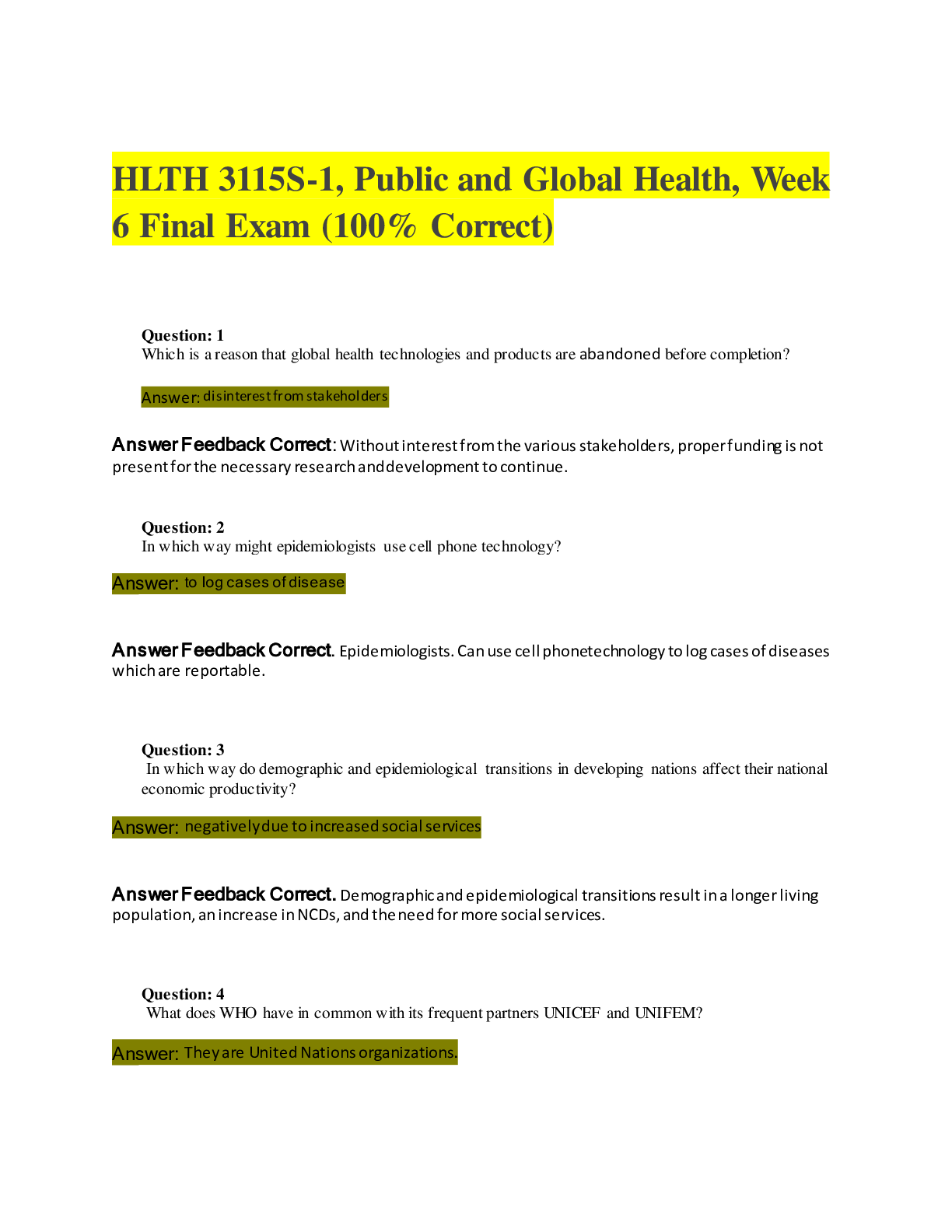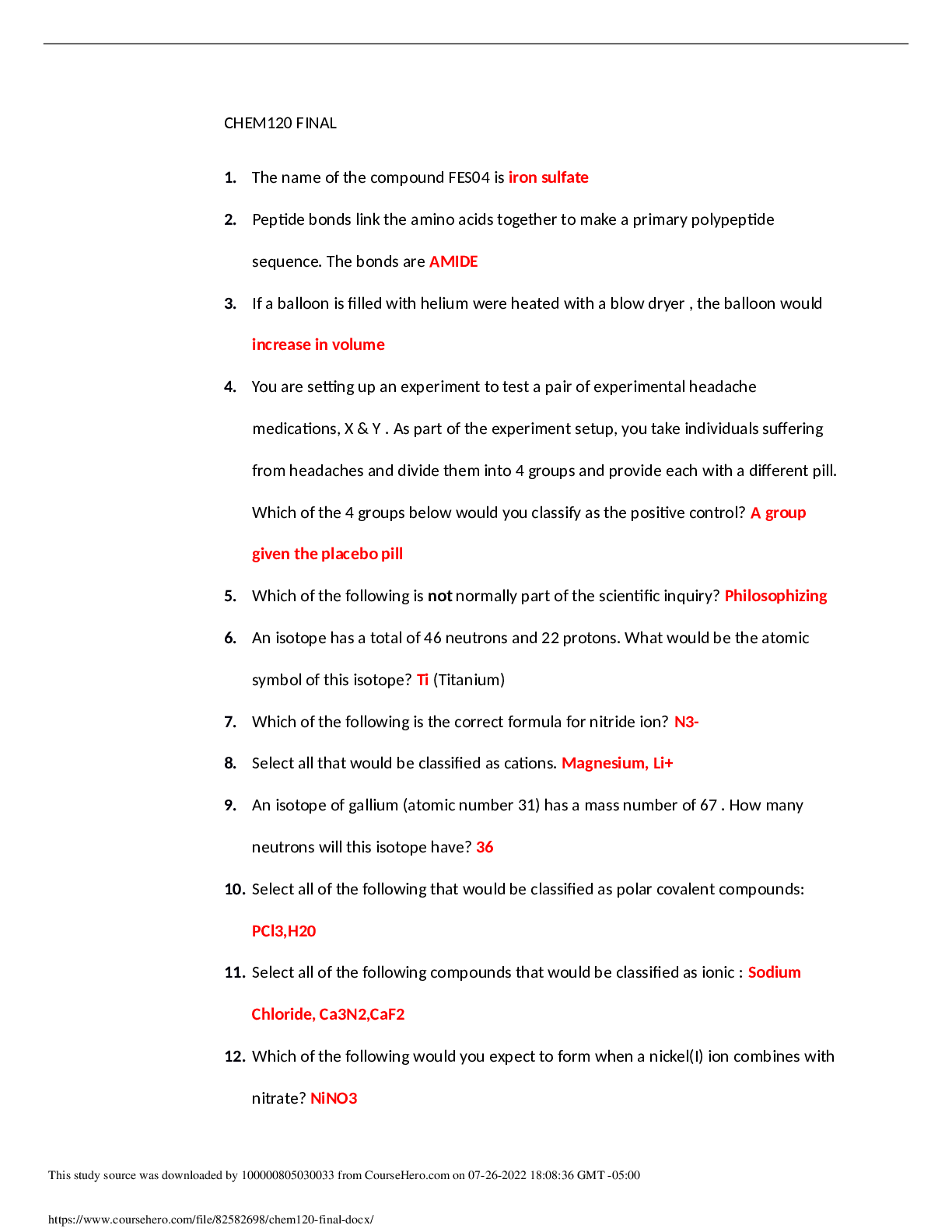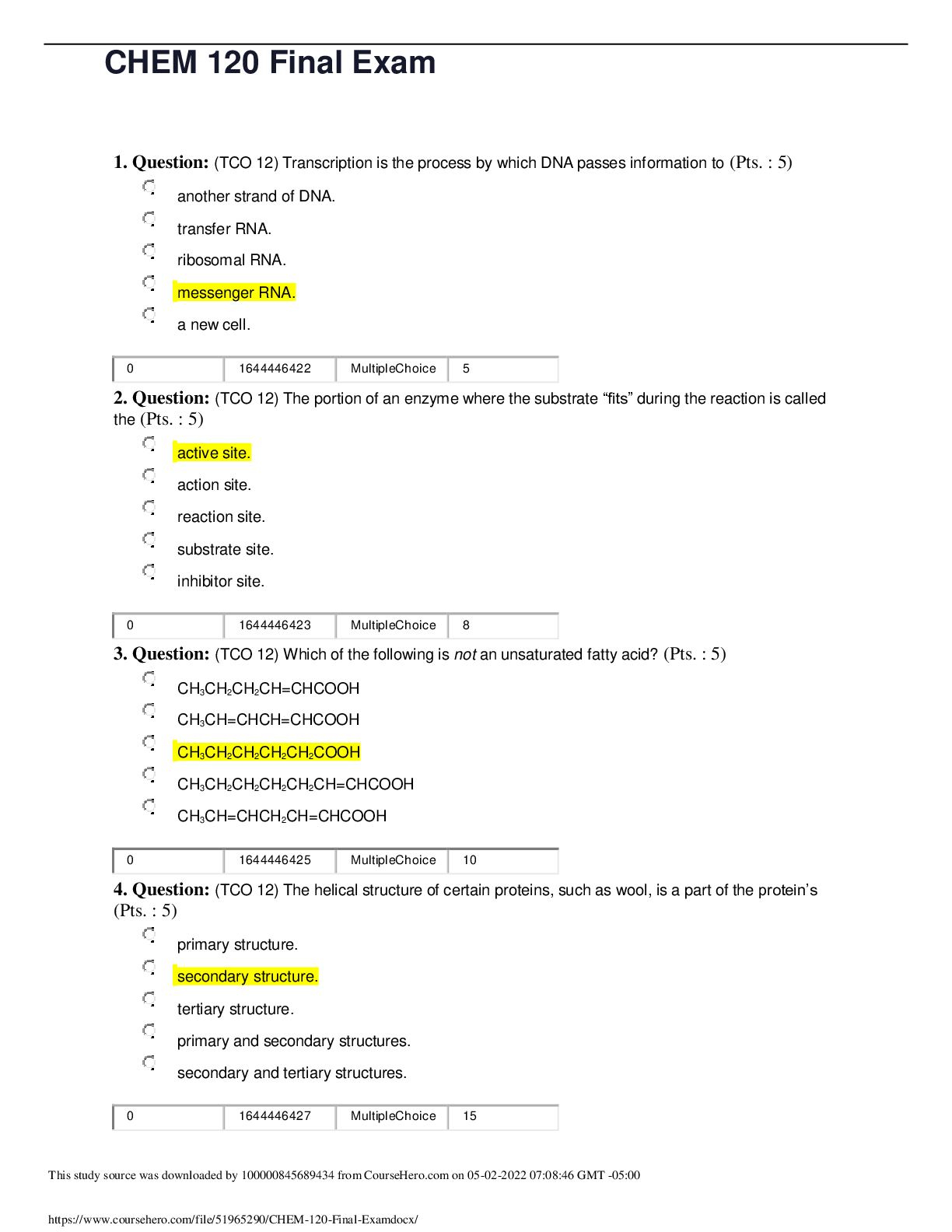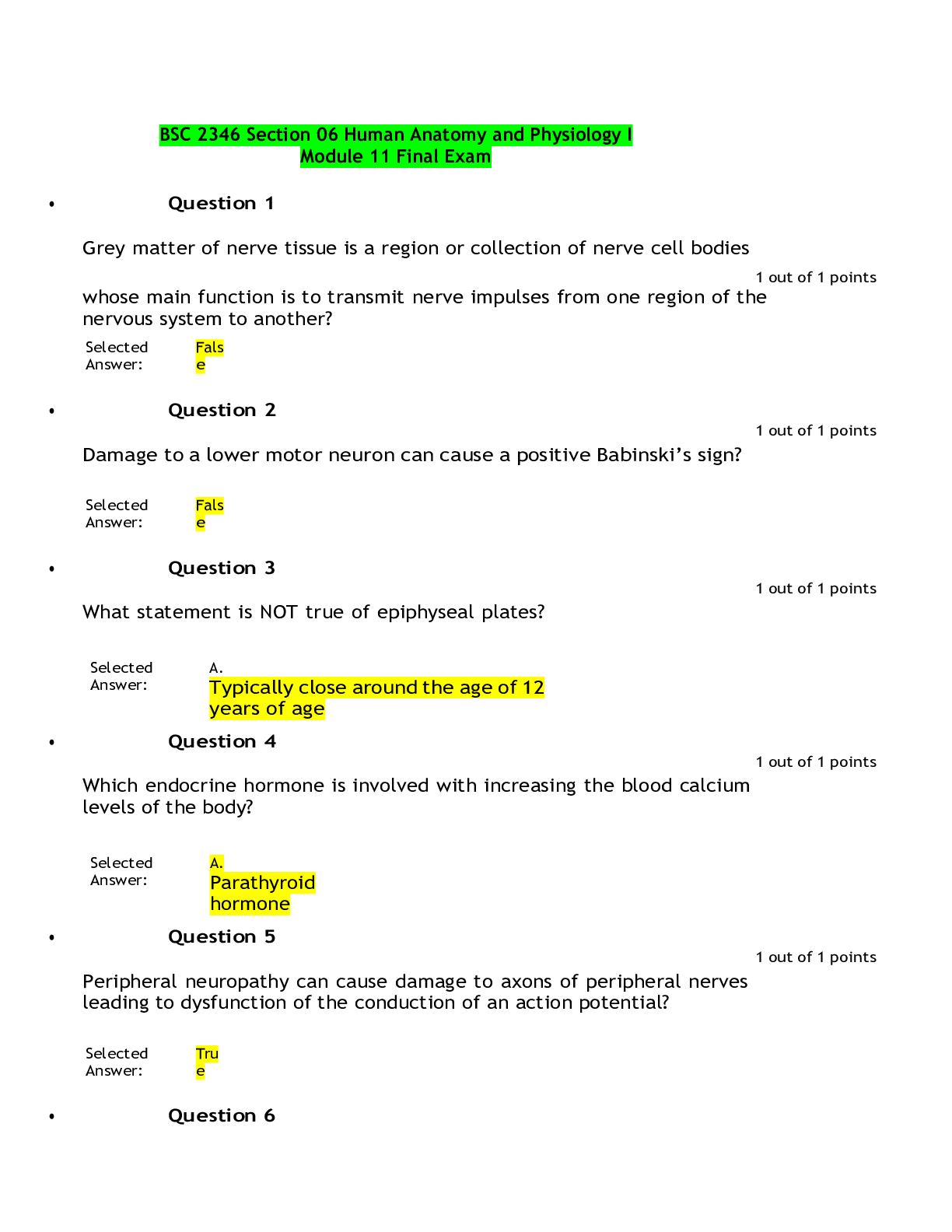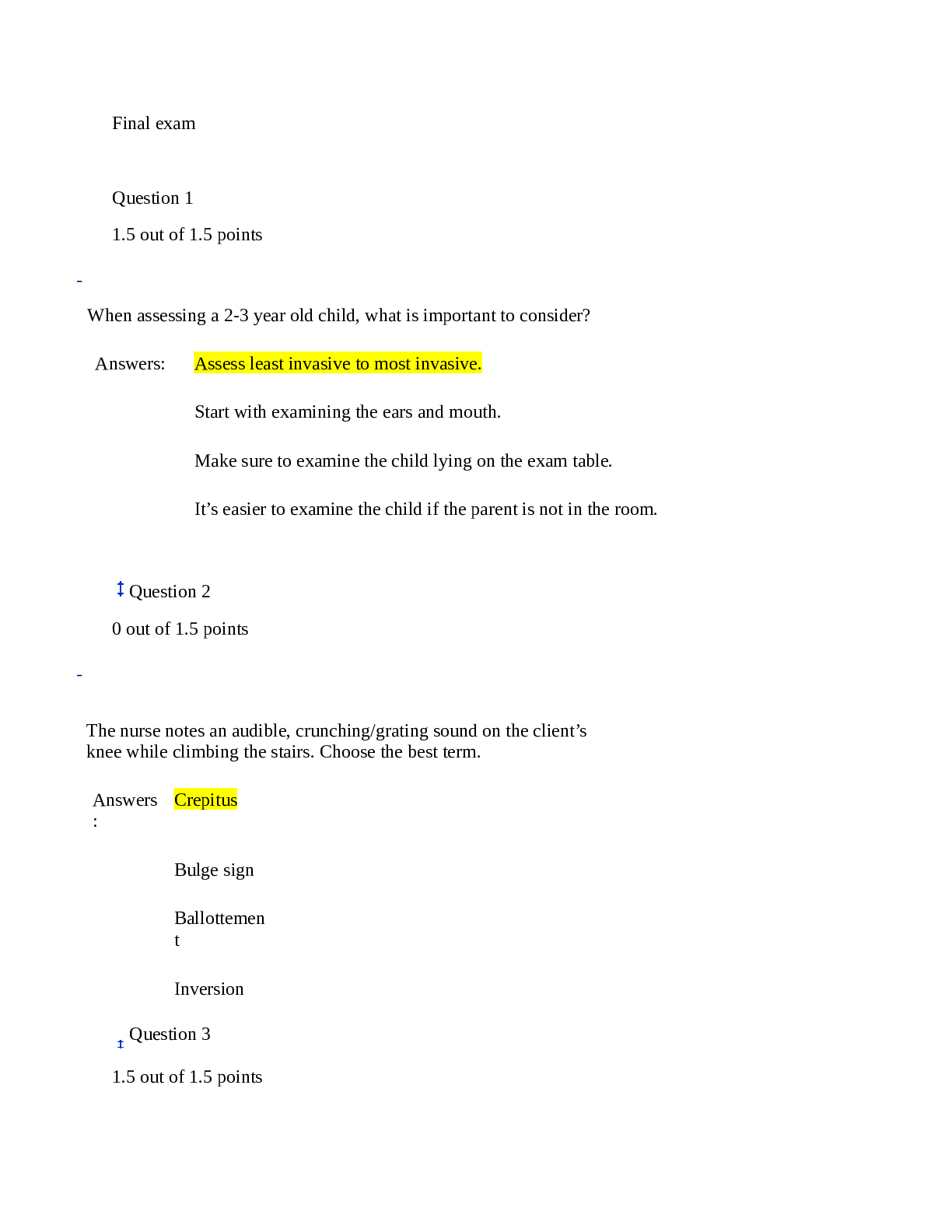NURS 6560 Final Exam (100% Correct Answers)
Document Content and Description Below
Question: The AGACNP is reviewing a chart of a head-injured patient. Which of the following would alert the AGACNP for the possibility that the patient is over …, thereby increasing the risk for inc... reased intracranial pressure? NURS 6560 Final Question: A patient who has … in the intensive care unit for 17 days develops hyponatremic hyperosmolality. The patient weighs 132 lb (59.9 kg), … , and is receiving mechanical ventilation. The serum osmolality is 320 mOsm/L kg H2O. Clinical signs include tachycardia and hypotension. The adult-gerontology acute care nurse practitioner’s initial treatment is to: Question: A 16-year-old male presents with fever and right lower quadrant discomfort. He complains of nausea and has had one episode of vomiting, but he denies any diarrhea. His vital signs are as follows: temperature 101.9°F, pulse 100 bpm, respirations 16 breaths per minute, and blood pressure 110/70 mm Hg. A complete blood count reveals a WBC count of 19,100 cells/µL. The AGACNP expects that physical examination will reveal: NURS 6560 Final Question: Myasthenia gravis is best … as: Question: Coates is a 65-year-old female who is on postoperative day 1 following a duodenal resection for a bleeding ulcer. She had an uneventful immediate postoperative course, but throughout the course of day 1 she has … of a mild abdominal discomfort that has … throughout the day. This evening the AGACNP is … to the bedside to evaluate the patient for persistent and progressive discomfort. Likely causes of her symptoms include all of the following except: Question: Coates is a 65-year-old female who is on postoperative day 1 following a duodenal resection for a bleeding ulcer. She had an uneventful immediate postoperative course, but throughout the course of day 1 she has complained of a mild abdominal discomfort that has … throughout the day. This evening the AGACNP is … to the bedside to evaluate the patient for persistent and progressive discomfort. Likely causes of her symptoms include all of the following except: NURS 6560 Final Question: When a patient is … with a possible stroke, the AGACNP recognizes that the stroke most likely resulted from a subarachnoid hemorrhage when the patient’s family reports that the patient: Question: You are … a 29 year old female complaining of abdominal pain. She states she is experiencing constant RUQ pain that radiates to her back. The pain is not … by bowel movements, over the counter antacids or food. Review of initial labs shows elevated amylase and lipase and you diagnose her with acute pancreatitis. Which test will you order next to determine the underlying cause of her pancreatitis? Question: Jake is a 32-year-old patient who is recovering from major abdominal surgery and organ resection following a catastrophic motor vehicle accident. Due to the nature of his injuries, a large portion of his jejunum had to … resected. In planning for his recovery and nutritional needs, the AGACNP considers that: Question: A 32-year-old man comes to the clinic because he has had pain in the back for the past 24 hours. The patient says he first … the pain when he awoke in the morning and had difficulty getting out of bed. He had been playing flag football the day before the pain began but did not sustain any injuries during the game. Acetaminophen has provided only minimal relief of the patient’s pain. On physical examination, pain is … on palpation of the back on the left, lateral to the region of L2-L5. Full range of motion is … in vertebral flexion, extension, lateral rotation, and lateral bending, with some hesitancy because of pain on the left side. Which of the following is the most appropriate initial step? Question: On postoperative day 7 following hepatic transplant, the patient evidences signs and symptoms of acute rejection, confirmed by histologic examination. The AGACNP knows that first-line treatment of acute rejection consists of: Cyclosporine Question: W. is a 33-year-old female who is being … after a fall from a tree. Anteroposterior and lateral radiographs of the thoracolumbosacral spine are significant for transverse process fractures at T6 and T7. The AGACNP knows that treatment for this likely will include: Question: Acute hepatitis A is usually diagnosed by: NURS 6560 Final Question: A 30-year-old male patient presents for evaluation of a lump on his neck. He denies pain, itch, erythema, edema, or any other symptoms. He is ^concerned because it won’t ^ go away. He says, “I noticed it a few months ago, then it seemed to disappear, and now it is back.” The AGACNP proceeds with a history and physical exam and concludes which of the following as the leading differential … ? Question: E. is a 61-year-old female who presents for a postoperative visit following a gastric resection after a perforation of peptic ulcer. She reports feeling better, although it is taking longer than she expected. However, she says she is feeling better each day, her appetite is returning, and her incision is healing well. She is being … from surgical care and advised to continue her routine health promotion follow-up with her primary care provider. As part of her surgical discharge teaching, the AGACNP counsels P. E. that as a result of her gastric resection she will need lifelong follow-up of: Blood group substances Question: O. is a 31-year-old male patient who is transported to the emergency department via emergency services. He was in a multivehicle accident and was trapped in a crushed car for more than 3 hours. On examination, his right lower extremity is found to … tensely swollen, with 3+ nonpitting edema. The lower leg is profoundly painful with passive range of motion. Given the history and physical findings, the AGACNP recognizes that treatment centers around: Question: While consulting on a patient who is admitted with a chief complaint of abdominal pain, the AGACNP notes that the initial assessment … the pain as “colicky.” This means that the pain: Question: All of the following are … findings in a patient with a T10 fracture except: Question: O. is a 44-year-old female patient who presents for evaluation of sudden, severe upper abdominal pain. She is clear about the onset, which was profound and occurred approximately one hour ago. She denies that the onset had anyrelationship to food or eating, and she denies nausea or vomiting. On examination, she is lying on her right side with her hips and knees … to draw her knees to her chest. Vital signs are stable, but examination reveals involuntary guarding. The abdomen is painful and tympanic to percussion in all quadrants. CBC reveals a white blood cell count of 15,600/µL. The AGACNP suspects: Question: The AGACNP is covering an internal medicine service and is paged by staff to see a patient who has just pulled out his ET tube. After the situation has been …, it is clear that the patient will go into respiratory failure and likely die if he is not reintubated. The patient is awake and alert and is adamant that he does not want to … reintubated. The AGACNP is concerned that there is not enough time to establish a DNR—the patient needs to … reintubated immediately and already is becoming obtunded. Which ethical principles are in conflict here? Question: In myelodysplastic syndromes, the primary indications for splenectomy include: Question: Which of the following situations constitute a positive screening after a PPD (purified protein derivative) skin test for tuberculosis? Question: When the patient with jaundice is evaluated, a careful history and physical exam often can help differentiate prehepatic, hepatic, and posthepatic causes. When the patient reports dark discoloration of the urine and light discoloration of the stool, the AGACNP is most suspicious for: Question: Jack R. is a 63-year-old male who is being … today on rounds after being … for profound upper abdominal pain, nausea, and vomiting. He had markedly elevated serum amylase and lipase; he was diagnosed with pancreatitis and admitted for pain management and bowel rest. Today he feels better, but he is upset because he knows that pancreatitisis … as the “alcoholic’s disease. ”He makes it clear that he is a religious man and that his religion forbids alcohol; he says he has never had an alcoholic drink in his life. The AGACNP reassures Jack that approximately 40% of cases of pancreatitis arecaused by as well as a variety of other things, and that he will have a thorough diagnostic evaluation. Question: In neurogenic shock, patients are … to an abnormal dilation of venules and arterioles in response to failure of the autonomic nervous system. Treatment for neurogenic shock may include all of the following except: Trendelenburg Question: Which of the following is a true statement with respect to the use of corticosteroids in posttransplant patients? High-dose initial steroids are … to off over a period of 4 to 6 weeks posttransplant Question: The comprehensive serologic assessment of a patient with Cushing’s syndrome is likely to produce which constellation of findings? Question: A patient admitted for management of sepsis is critically ill and wants to talk with a hospital representative about donating hero rgansifshedies. She has a fairly complex medical history that includes traumatic brain injury,breast cancer, and dialysis-dependent renal failure. The patient is … that she is ineligible to donate due to her: Renalfailure Question: Elmerisa61-year-old male who is … vomiting bright red blood. He has no … medical history—he has not been in the health care system for most of his adult life. He has lost a lot of volume, and his vital signs are borderline unstable with a blood pressure of 88/58 mm Hg, pulse of 118 bpm, respiratory rate of 12 bpm, and a temperature of 97.6°F. The AGACNP recognizes that the leading differentials include all of the followingexcept: Question: S. is a 31-year-old female who is … following a catastrophic industrial accident. She had multiple injuries, and after a 10-day hospital stay that included several operations and attempts to save her, she is declared brain dead. She had an organ donor notation on her driver’s license. Which of the following circumstances precludes her from serving as a liver donor? Question: N. is a 61-year-old male who is referred to the emergency department by a local retail clinic. M. N. has not had regular health care at any time in his adult life; he says he doesn’t know when he last saw a doctor. His daughter finally talked him into going to the local retail health clinic when his abdomen became so … that he couldn’t pull his pants up. M. N. says that he has put on some weight over the last few weeks but he has not felt ill. He admits to drinking> 4 drinks of whiskey daily; he says he smokes 2 packs of cigarettes a day and is not very active. He has … alone since his divorce 20 years ago. Physical examination reveals an adult male who is chronically ill in appearance and appears older than … age. His vital signs are within normal limits, and physical examination is significant only for obviousascites. Paracentesis and subsequent analysis of the fluid reveals an ascites LDH to serum LDH ratio of 0.8. The AGACNP knows that this ratio is highly suspicious for: Question: The AGACNP is treating a patient with ascites. After a regimen of 200 mg of spironolactone daily, the patient demonstrates a weight loss of 0.75 kg/day. The best approach to this patient’s management is to: Question: The AGACNP knows that following bilateral total adrenalectomy, the patient will require: Prednisone 15 mg qam and 10 mg qpm Question: Josh is a 14-year-old male patient who presents for evaluation of blurred vision. His only significant injury is that over the weekend he was playing baseball and was hit in the side of the head by a flying ball. The hit was hard enough to knock him down, but he did not lose consciousness and had no remarkable symptoms. Now on Wednesday he presents with a dull headache that seems to … getting worse, and his mom wants to have him evaluated. Neurologic examination reveals a sluggish pupillary response. CT scan of the head reveals a 1 cm epidural hematoma. The AGACNP knows that the best approach to management would …: Question: isa39-year-old female who presents with persistent abdominal discomfort. She denies actual pain but says she has this persistent sense of fullness in her abdomen that feels like it would go away if she could have a bowel movement. This finding is … as: Question: Tim is an 20 year old junior at Notre Dame and injured his right knee during an intramural football game and comes to the ER complaining of severe pain. Tim tells you that he was setting up to pass the football when he was … and he immediately felt his knee “pop” and buckle as he fell. You, as the AGACNP, know the most important information to obtain from Tim is: Question: Nguyen is an 84-year-old female who suffered a fall in her long-term care facility. After assessing possible reasons for her fall, a physical examination is … to look for injuries. Mrs. Nguyen has significant pain in her left upper arm and limited range of motion in her left shoulder; a shoulder trauma series is … to evaluate for which type of injury that … occurs in these circumstances? Question: A general principle in surgical oncology is that the best approach to curative surgery in a fixed tumor requires: Question: Intracranial pressure monitoring is … for a patient with a head injury. The patient’s arterial blood pressure is 92/50mmHg,and her intracranial pressure is 18 mm Hg. Using these values to calculate the patient’s cerebral pressure (CPP) the AGACNP determines: Question: Jefferson is a 59-year-old male who presents to the emergency department complaining of severe abdominal pain. His medical history is significant for dyslipidemia, and he takes 40 mg of sim vastatin daily. He admits to drinking 6 to 10 bottles of beer nightly and to smoking 1½ packs of cigarettes a day. He denies any history of chest pain or cardiovascular disease. He was in his usual state of good health until a couple of hours ago, when he developed this acute onset of severe pain in the upper abdomen. He says that he tried to wait it out at home but it was so bad he finally came in. His vital signs are as follows: temperature 99.1°F, pulse 129 bpm, respirations 22 breaths per minute, and blood pressure 137/84 mm Hg. The abdomen is diffusely tender to palpation with some guarding but no rebound tenderness. The AGACNP anticipates that which of the following laboratory tests will … abnormal? Question: S. is a 31-year-old male who complains of gastric discomfort that he notices mostly on an empty stomach; for example, if he works late and does not have the opportunity to eat, he notices that it happens. It feels better when he eats something or even if he just take TUMS®. Physical examination reveals a generally healthy adult male with normal vital signs. There is a bit of mild discomfort with deep palpation to the epigastrum, but otherwise the abdominal exam is normal. The AGACNP know that the most useful laboratory analyses will include: Question: The AGACNP is rounding on a patient following splenectomy for idiopathic thrombocytopenia purpura. On postoperative day 2, a review of the laboratory studies is … to reveal: Question: Carolyn C. has a history of Crohn’s disease and has been … with immunologic agents, with moderate success. Today she presents with severe abdominal pain that comes and goes in waves; it started shortly after she ate a little bit of cottage cheese and crackers. This has never happened before with her Crohn’s disease. She has difficulty localizing the pain but seems to indicate the general area of the umbilicus. She had one episode of diarrhea this morning. Question: A 30 year old female nurse comes to your office with complaints of epigastric pain that awakens her at night. She admits to being under a lot of stress at work and takes 2400 mg of ibuprofen for menstrual cramps and low back pain 5-6 times a week, especially after heavy lifting. She smokes a pack of cigarettes a day. Her physical exam is unremarkable but she does have positive heme stools. She is … for an upper endoscopy which reveals a duodenal ulcer. Given this history,what is the most likely etiology of her ulcer? Question: An open fracture is … an orthopedic emergency. Emergency room management of open fracture must include: Immediate covering with iodine-soaked gauze Question: Grant Pass is a 20 year old downhill skier for the U. S Olympic team. He was on a practice run in Salt Lake City and caught a ski tip on a mogul and became air born and … into the padded barriers on the side of the course. He was momentarily stunned, but was walking around … and was conversant when the ski patrol paramedics …. The paramedics placed him on a backboard and began to slowly ski down to the end of the course where an ambulance was waiting to take him to the local trauma center. When Grant was placed in the ambulance, the paramedics noted that Grant was somnolent and not responsive to verbal commands. They noted that his left pupil was dilated and sluggish to respond to light. … on the above information, you, as the ACNP in the ER, suspect that Grant … which of the following? Question: Maroldo is an 81-year-old female who presents for evaluation of pain in her left lower quadrant. She has had this pain before and says she usually takes antibiotics and it goes away. However, this time it seems worse, and she has had it for 4 days even though she says she … taking her leftover antibiotics from the last episode. She denies any nausea or vomiting but says she simply isn’t hungry. She had a little diarrhea yesterday but no bowel movements today. She has a temperature of 100.9° F and a pulse of 104 bpm, respirations of 20 breaths per minute, and a blood pressure of 94/60 mm Hg. She has some discomfort to deep palpation in the left lower quadrant. The AGACNP suspects: Question: G. is a 48-year-old female who presents with biliary colic. She has had previous episodes but has resisted operation because she is afraid of anesthesia. Today her physical exam reveals a clearly distressed middle-aged female with right upper quadrant pain, nausea, and vomiting. Which of the following findings suggests a complication that requires a surgical evaluation? Question: Tim is an 20 year old junior at Notre Dame and injured his right knee during an intramural football game and comes to the ER complaining of severe pain. Tim tells you that he was setting up to pass the football when he was tackled and he immediately felt his knee “pop” and buckle as he fell. What physical exam tests would you perform to confirm your differential diagnosis? Question: The AGACNP rounds on his brain injury patient and recognizes the development of progressive bradycardia, hypertension, and irregular respiratory pattern. This is … as Cushing’s triad and suggests: Question: Justin F. is … in the emergency department with an 8-cm jagged laceration on the dorsal surface of his right forearm. He says he was working with his brother-in-law yesterday morning building a deck on the back of his home. A pile of wooden planks fell on top of him, and he sustained a variety of cuts and superficial injuries. He cleaned the wound with soap and water but didn’t want to go to the emergency room because he didn’t want to risk being in the waiting room for hours. He wrapped up his arm and went back to work, and then … a normal shower and went to bed last night. This morning the cut on his arm was still flapping open, and he realized he needed sutures. The appropriate management of this patient includes: Question: A 49 year old female is … for sudden onset severe abdominal pain 10/10. On further questioning you learn that she has … epigastric pain for several months after eating, which has … in an 11 pound weight loss. She does not take any other medications. On physical exam you note she has a low grade fever of 100.1, HR 124, RR 25 and BP is 116/72. The abdomen is rigid and there are no bowel sounds. Abdominal plain film shows free air under the diaphragm. What is your diagnosis? Question: R. is a 71-year-old female who presents with left lower quadrant pain that started out as cramping but has become more constant over the last day. She reports constipation over the last few days but admits that for as long as she can remember she has had variable bowel habits. Her vital signs are normal, but physical examination reveals some tenderness in the left lower quadrant. What is the leading diagnosis for this patient? Question: T. is a 49-year-old male who has been admitted for the management of an episode of diverticulitis. This is his fifth hospitalization this year, and in previous hospitalizations he has had both abscess and stricture as a consequence of his disease. His treatment this hospitalization should include: Question: Sara S. is a 41-year-old patient who has just had a bone marrow transplant. The AGACNP knows that which medication will … to decrease her risk of graft-versus-host reaction? Question: The AGACNP is receiving report from the recovery room on a patient who just had surgical resection for pheochromocytoma. He knows that which class of drugs should … available immediately to manage hypertensive crisis, a possible consequence of physical manipulation of the adrenal medulla? Question: A 41-year-old male physician has a 6-week history of persistent painful, swollen, and stiff proximal interphalangeal joints, wrists, and ankles. Using a step wise progression model, which would … the first diagnostic test the AGACNP would order? Question: S., a 49-year-old male, is brought to the emergency room by his roommate who relates that the patient has been vomiting bright red blood for two days. He has a history of alcohol abuse. Current vital signs are as follows: Temp 99.2o F, heart rate 110 bpm (sinus tachycardia), blood pressure 90/60 mm Hg, resp 32 bpm. He is alert but lethargic and denies current abdominal pain. Which of the following is not … in the initial management of this patient? Question: A 38-year-old patient presents with symptoms of L5 nerve root impairment that have been ongoing for 3 weeks despite conservative treatment. All of the following statements regarding this case are true EXCEPT: Question: R. is a 71-year-old female who presents with left lower quadrant pain that … out as cramping but has become more constant over the last day. She reports constipation over the last few days but admits that for as long as she can remember she has had variable bowel habits. Her vital signs are normal, but physical examination reveals some tenderness in the left lower quadrant. Which diagnostic test is most likely to support the leading differential diagnosis? Question: A patient with chronic hepatic encephalopathy is … home. Discharge teaching centers upon long-term management strategies to prevent ammonia accumulation. Teaching for this patient includes instruction about: Question: Carpenter is a 28-year-old female who presents in significant pain; she indicates that the discomfort is in the right lower quadrant. The discomfort is colicky in nature and has the patient in tears. Which of the following … findings increases the index of suspicion for ureteral colic? Question: A 32-year-old patient who under went an open splenectomy for a ruptured spleenis preparing for discharge. An adult- gerontology acute care nurse practitioner reviews the potential complications with the patient. The nurse practitioner emphasizes which instruction to the patient? Question: When evaluating a patient with acute pancreatitis, which of the following physical or diagnostic findings is an ominous finding that indicates a seriously ill/potentially moribund patient? Question: Ted is a 22 year old male who fell on his right shoulder 2 days ago during a martial arts class. He is complaining of inability to sleep on his right side and has pain whenever he tries to use his arm. He denies any sensory changes in his hand. Nothing seems to make it better, even the ibuprofen he has been taking several times a day. Question: Based on the radiograph below, what is your working diagnosis at this time? NO PICTURE SHOWN: Question: W. is a 50-year-old woman who presents for surgical resection of the liver for treatment of metastatic colon cancer. Preoperatively, the surgeon tells her that he is planning to remove 50 to 75% of her liver. The patient is concerned that she will not … able to recover normal liver function with that much removed. The AGACNP counsels her that: Question: Joshua is a 31-year-old man who presents for evaluation of acute numbness and tingling and … strength in his arms. It happened rather suddenly this afternoon and has never happened before. The lower extremities do not appear to … affected. While performing the history the AGACNP asks specific questions about the risk of: Question: The AGACNP is taking report on a head injured patient. The report includes scoring on the Glasgow Coma Scale of E2 M3 V5. How would you interpret this information? Question: S. is a 49-year-old female with a history of colorectal cancer for which she has had surgical resection and chemotherapy. She presents with profound abdominal pain. She has not …, and she is not certain when she had her last normal bowel movement; her bowel habits have been irregular for some time. A CBC demonstrates a mild microcytic anemia but is otherwise normal; her WBC differential is normal. Results of a metabolic panel support minor volume contraction but show no significant electrolyte abnormalities. Abdominal radiographs demonstrate dilation of the proximal colon, air fluid levels, and a complete absence of air in the rectum. The AGACNP diagnoses the patient with: Perforated colon Question: Tim is an 20 year old junior at Notre Dame and injured his right knee during an intramural football game and comes to the ER complaining of severe pain. Tim tells you that he was setting up to pass the football when he was tackled and he immediately felt his knee “pop” and buckle as he fell. Which of the following diagnostics would the AGACNP order first? Question: Jane S. is a 35-year-old female patient who is at 30 weeks’ gestation. She is … regularly for prenatal care and has always been healthy; she just had an office visit and was told everything was fine. Tonight she presents to the emergency room complaining of significant pain in the upper abdomen. Her vital signs reveal a temperature of 98.4°F, pulse of 110 bpm, respirations of 20 breaths per minute, and blood pressure of 144/90 mm Hg. A urinalysis reveals proteinuria, and a metabolic panel is significant for increased transaminases. Her hemogram is normal, but the CVC reveals platelets of 85,000. The AGACNP knows that which of the following must … evaluated as a cause of her abdominal pain? Question: A 52-year-old male comes to the clinic in preparation for an overseas trip next year. He has already searched the internet and knows that Hepatitis A and Hepatitis B are endemic in the country that he will … visiting. What will you recommend to this patient? Question: Warner is a 64-year-old male who presents with multiple skin lesions scattered about his head, neck, shoulders, and arms. They range in size from 3 mm to 1.2 cm. They do not hurt, burn, or itch, but they are rough to palpation—like sandpaper. Mr. Warner has a history of basal cell carcinoma × 3 and wants to know if these are also skin cancer. The AGACNP tells him that these lesions may … precancerous and are … as: Question: Brad Berry, a 30-year-old male, presents to the ED with the chief complaint of a red, hot, swollen, painful right knee. He first noticed the problem last night, and feels it has gotten worse over the past 14 hours.Your medical history reveals that Mr. Berry denies problems with any other joints or recent injury to his right knee. He is not sexually active and currently is attending seminary school. He denies urethral discharge or urinary symptoms, recent rash, IV drug use, chronic illness, or recent camping. His temperature is 102.2 F. Physical exam reveals normal general survey, cardiorespiratory and abdominal examination. The right knee is markedly swollen with + fluid wave. There are no inguinal lymph nodes palpated. Which of the following would … the first diagnostic test for the AGACNP to order? Question: The AGACNP screens a new admit patient for liver disease. Elevations of all of the following would confirm your suspicion that this patient has liver disease, EXCEPT Question: C. is a 60-year-old female with primary hyper aldosteronism. She has been … to your service for surgical management. Anticipated findings on clinical history would include: Question: Janice is a 32-year-old female who presents for evaluation of abdominal pain. She has no significant medical or surgical history and denies any history of ulcers, reflux, or gastritis. However, she is now in significant pain and is afraid something is “really wrong.” She describes what … out as a dull discomfort in the upper part of her stomach a few hours ago but has now become more profound and centered on the right side just under her ribcage. She has not vomited but says she feels nauseous. Physical exam reveals normal vital signs except for a pulse of 117 bpm. She is clearly uncomfortable, and palpation of the abdomen reveals tenderness with deep palpation of the right upper quadrant. The AGACNP orders which imaging study to investigate the likely cause? NURS 6560 Final Question: The AGACNP knows that early diagnostic findings consistent with rheumatoid arthritis include: Question: The ethical principle of veracity refers to: Question: Huckabee is a 51-year-old male who had a CT scan of the abdomen to evaluate refractory left lower quadrant discomfort. The scan reported an incidental finding of cholelithiasis with calcified gallbladder. While counseling Mr. Huckabee about the results, the AGACNP advises that the appropriate approach to these findings is: Question: Miller is a 56-year-old male who is being managed for portal hypertension. The AGACNP knows that of the many causes of portal hypertension, alcoholic liver disease typically is the cause when the patient has: NURS 6560 Final Question: Neoadjuvant chemotherapy treatment for cancer is given to facilitate surgical resection. When the outcomes of cancer therapies are …, the terms complete response and partial response often are … Partial response means that: Question: Teller presents with a chief complaint of weight loss. She reports an … 10 lb weight loss over the last 5-6 months. She has no significant medical history, but review of systems reveals bilateral shoulder discomfort and some impaired range of motion — she has trouble pulling clothing over her head. Over the last few months she has generalized upper body stiffness, but seems to get better after an hour or so of activity. When considering a diagnosis of polymyalgia rheumatica, laboratory assessment may … to reveal: Question: R. is a 52-year-old female who presents complaining of significant abdominal pain, which she rates as 8 to 9 on a 1 to 10 scale. The pain has been going on for a matter of hours, and she is afraid it won’t go away on its own. She denies any nausea or vomiting, and she cannot remember precisely when her last bowel movement …; probably it was a few days ago. She reports that she is “always” … On physical examination, she is tachycardic but otherwise has normal vital signs; her abdomen is tensely rigid, but no point tenderness to palpation is … The entireabdomen percusses as tympanic—there is no distinct dullness over the upper quadrants. Bowel sounds are present but hypoactive and intermittent. There is rebound tenderness to palpation. The AGACNP suspects: Question: A patient with suspected Cushing’s syndrome is being … diagnosis and cause. Patients with an adrenal tumor typically will demonstrate: Question: A 25-year-old medical student is stuck with a hollow needle during a procedure on a patient … to have hepatitis B viral infection but who is HIV-negative. The student’s baseline laboratory studies include serology: HBsAG negative, total Anti-HBc negative, IgM Anti-HBc -, Anti-HBs +. Which of the following is true regarding this medical student’s hepatitis status? NURS 6560 Final Question: A 55-year-old man with a past medical history of hypertension and hyperlipidemia presents to your office with an acute onset of fevers, chills, dysuria, urinary frequency and right CVA tenderness. On exam he appears to … moderately ill, with a temperature of 39.3°C, pulse of 105/min and a blood pressure of 115/60mmHg. His cardiopulmonary and abdominal exam are negative. A urine dip in the office reveals 2+ blood, 2+ leukocytes and negative nitrates. Of the following tests, which is most likely to lead to the correct diagnosis? NURS 6560 Final Question: R. is a 51-year-old male patient who is being … for fatigue. Over the last few months he has noticed a marked decrease in activity tolerance. Physical examination reveals a variety of ecchymoses of . origin. The CBC is significant for a Hgb of 10.1 g/dL, an MCV of 72 fL and a platelet count of 65,000/µL; the remainder of … the CBC is normal. Coagulation studies are normal, but bleeding time is … The AGACNP recognizes that initial management of this patient will include: Question: Elliotis a 47-year-old male who is being …for throat cancer with combination therapy that includes radiation. He is asking questions about what adverse effects he may anticipate. The AGACNP advises Elliot that the most significant toxic effects in the acute / early post radiation period are: Question: The AGACNP knows that when evaluating a patient with … acute pyelonephritis, which of the following is not a common feature? NURS 6560 Final Question: D. is a 13-year-old male patient who has a history of recurrent fever and flank pain. His parents traditionally are not believers in the health care system, and he has not been … by a health care provider for many years. Today he has fever, chills, and costovertebral angle tenderness. Urinalysis reveals findings consistent with acute urinary infection. The AGACNP treats the patient for pyelonephritis and considers which study to evaluate for vesicoureteral reflux? Question: Maxine is being … in follow-up after removal of an aldosteronoma. The AGACNP expects specifically that which of the following aldosterone-related abnormalities will … cured? Question: Acute hepatitis B is diagnosed by: NURS 6560 Final Question: A 19-year-old woman presents to your office with a 3-day history of dysuria and foul-smelling urine. She also notes some suprapubic pressure and noted some chills and she thinks she had a fever yesterday. She reports no vaginal bleeding or discharge and reports no nausea or vomiting. She denies any significant past medical history. On exam she has a temperature of 38°C, a pulse of 105/min and a blood pressure of 120/75 mm Hg. Her abdominal exam reveals some suprapubic tenderness. Her back exam reveals no cost over tebral angle tenderness. Urine dip demonstrates 2+ leukocytes. What should … done next? Question: Brad Berry, a 30-year-old male, presents to the ED with the chief complaint of a red, hot, swollen, painful right knee. He first … the problem last night, and feels it has gotten worse over the past 14 hours.Your medical history reveals that Mr. Berry denies problems with any other joints or recent injury to his right knee. He is not sexually active and currently is attending seminary school. He denies urethral discharge or urinary symptoms, recent rash, IV drug use, chronic illness, or recent camping. His temperature is 102.2 F. Physical exam reveals normal general survey, cardiorespiratory and abdominal examination. The right knee is … swollen with + fluid wave. There are no inguinal lymph nodes palpated. In your immediate consideration of differential diagnoses for Mr. Berry’s knee problem, … the least likely? NURS 6560 Final Question: The AGACNP is evaluating a 79-year-old male in the emergency department. He is extremely anxious and requires significant reassurance that he is not going to die. He subsequently rules in for an anterolateral myocardial infarction. His daughter asks you not to tell the patient the truth. She is afraid that it will compound his anxiety, agitate him, andworsenhiscondition.Thepatientbecomesupsetanddemandstobetoldpreciselywhathisconditionis.Themost appropriate action would … to: Question: Knicker son is a 77-year-old female admitted for management of urinary tract infection. Her complete blood count reveals a white blood cell differential as follows: Total leukocyte count 57,000 cells/uL, neutrophils of 16%, lymphocytes 77%, monocytes 3%, eosinophils 3% basophils 1%. The AGACNP is suspicious for: NURS 6560 Final Question: A 54-year-old man with a history of metastatic lung cancer comes to the office because he had sudden onset of pain in the lower back and both legs 24 hours ago. Which of the following findings would indicate that a lumbar disk herniation rather than a cauda equina syndrome is the cause of his pain? Question: The Ranson’s Criteria of Severity is a morbidity and mortality index … to predict risk in patients with acute pancreatitis. A Ranson score of 3 indicates: [Show More]
Last updated: 1 year ago
Preview 1 out of 28 pages
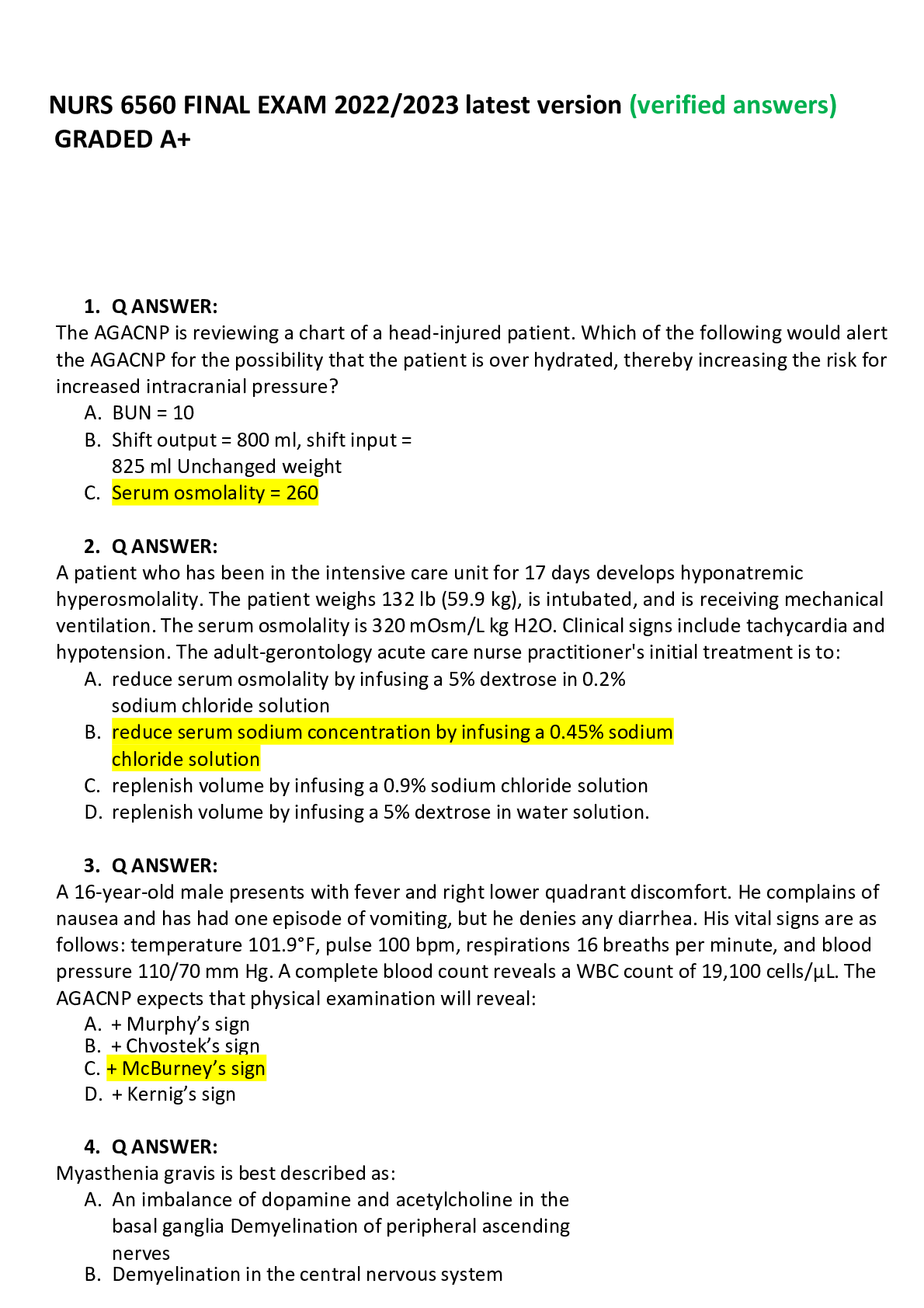
Reviews( 0 )
Document information
Connected school, study & course
About the document
Uploaded On
Jul 05, 2022
Number of pages
28
Written in
Additional information
This document has been written for:
Uploaded
Jul 05, 2022
Downloads
0
Views
34

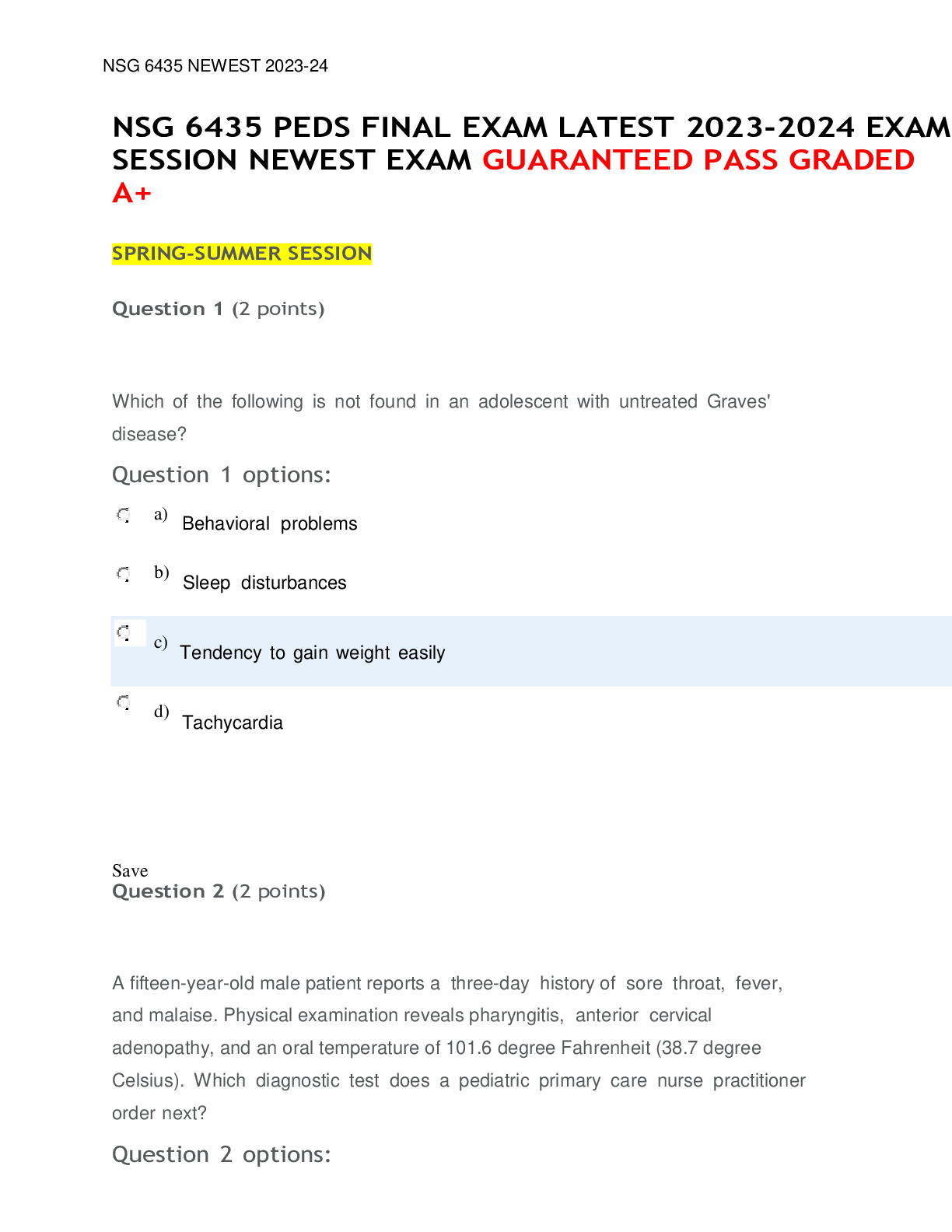
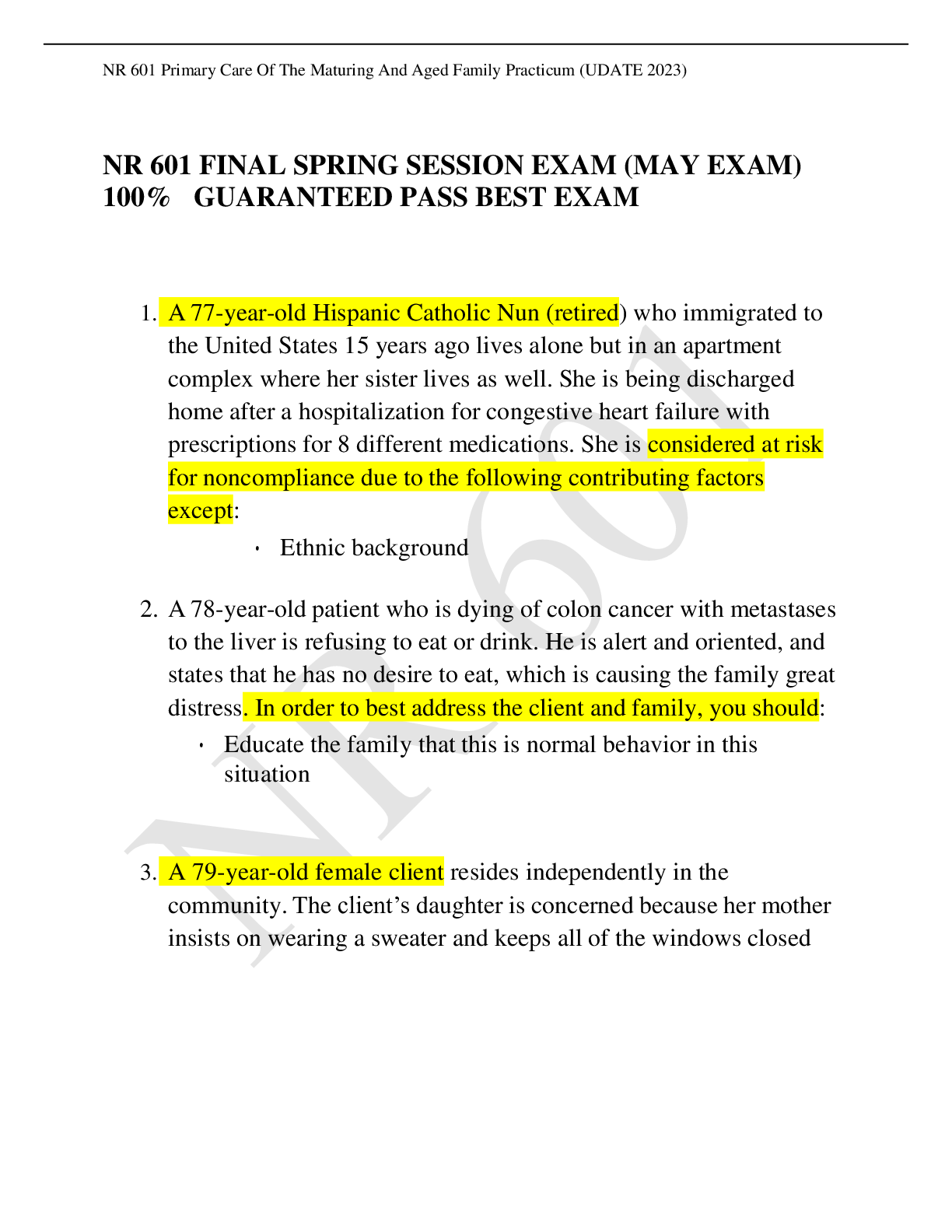
 EXAM REVIEW WITH RATIONALE GRADED A+ VERIFIED.png)
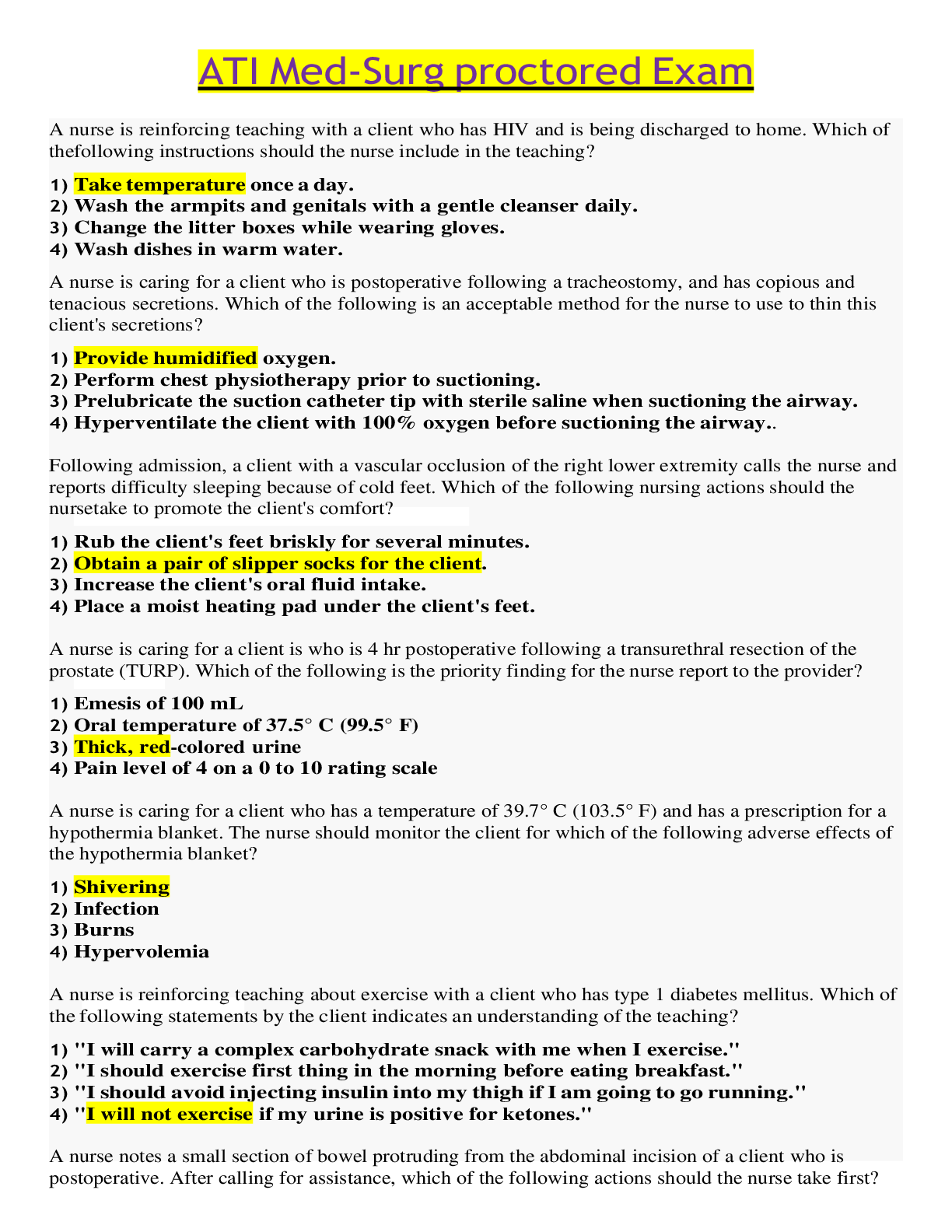
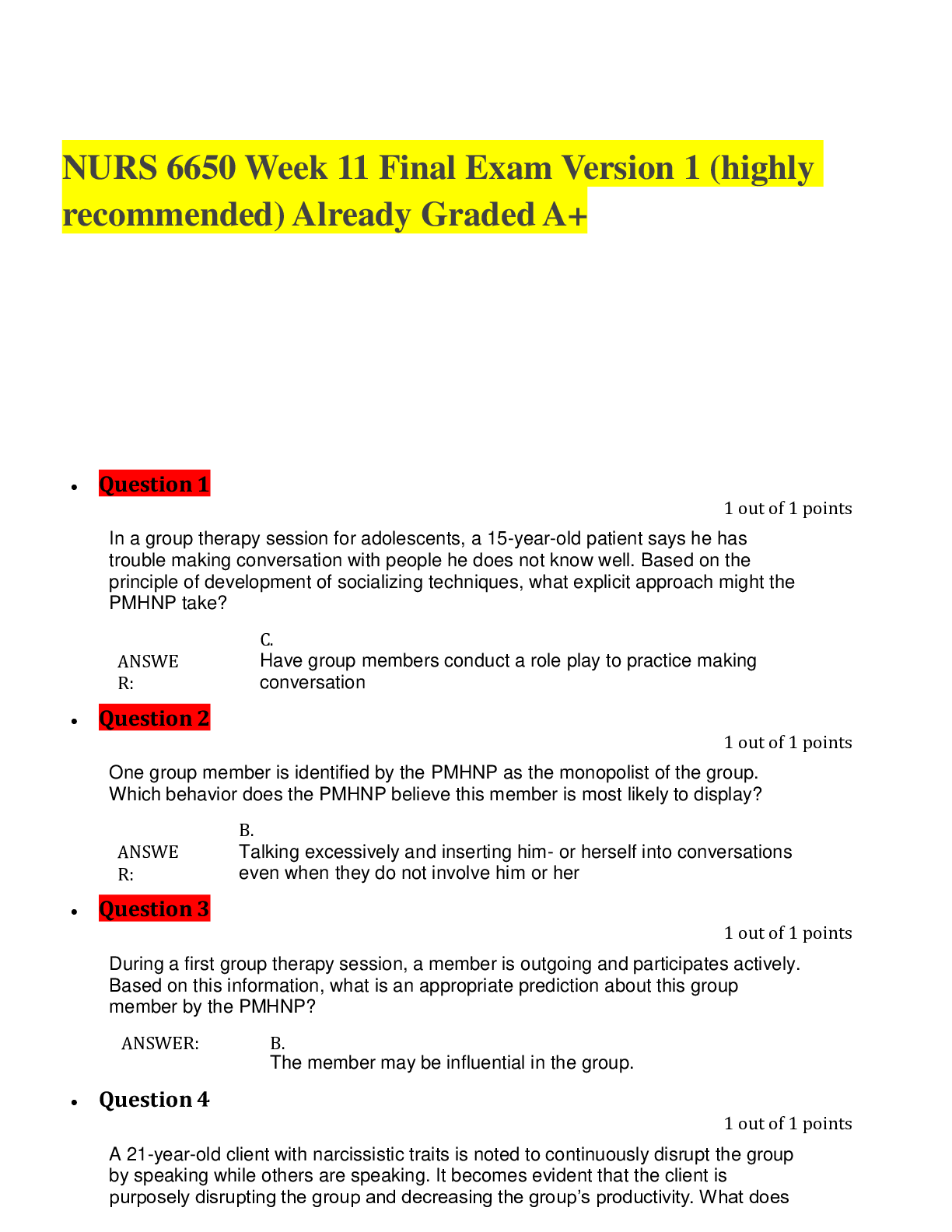
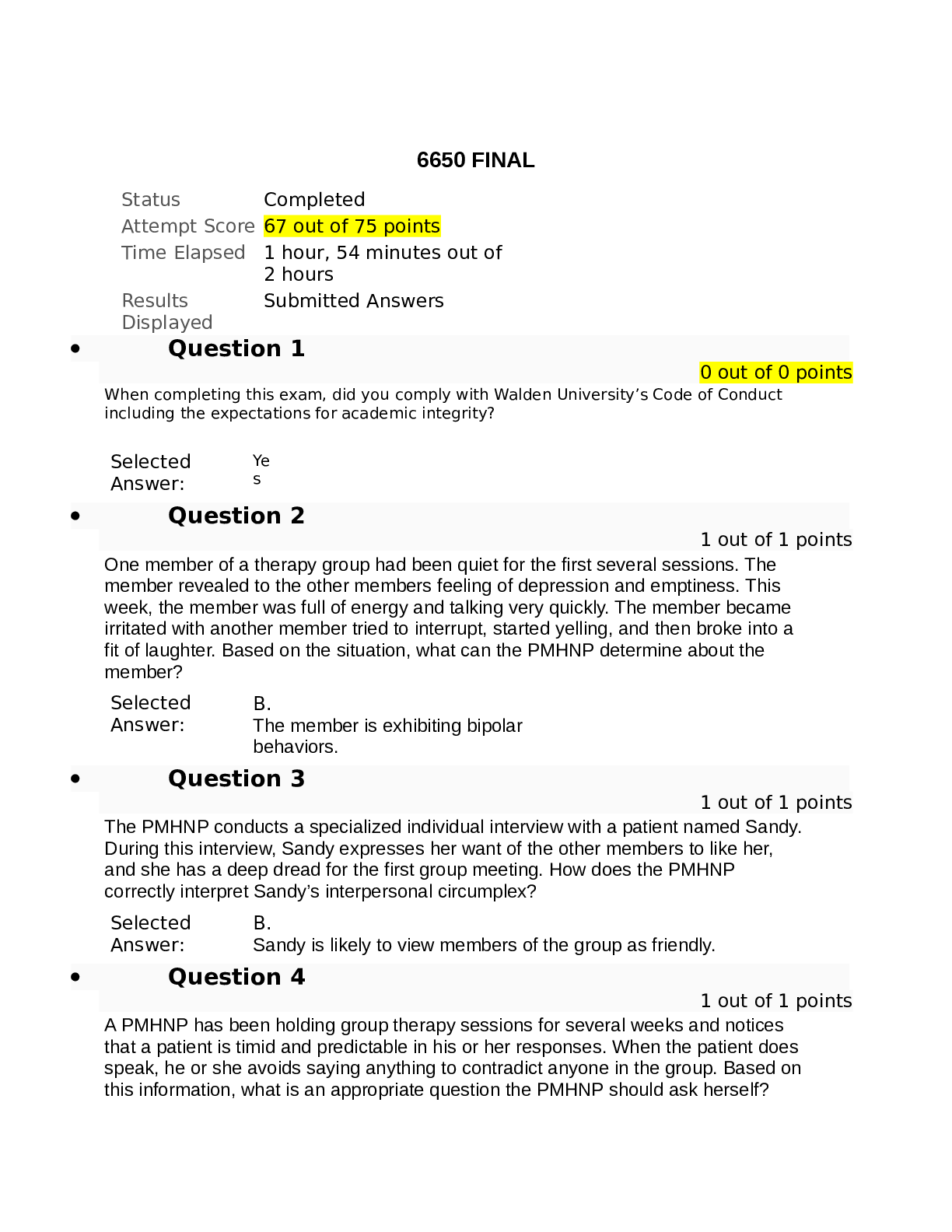
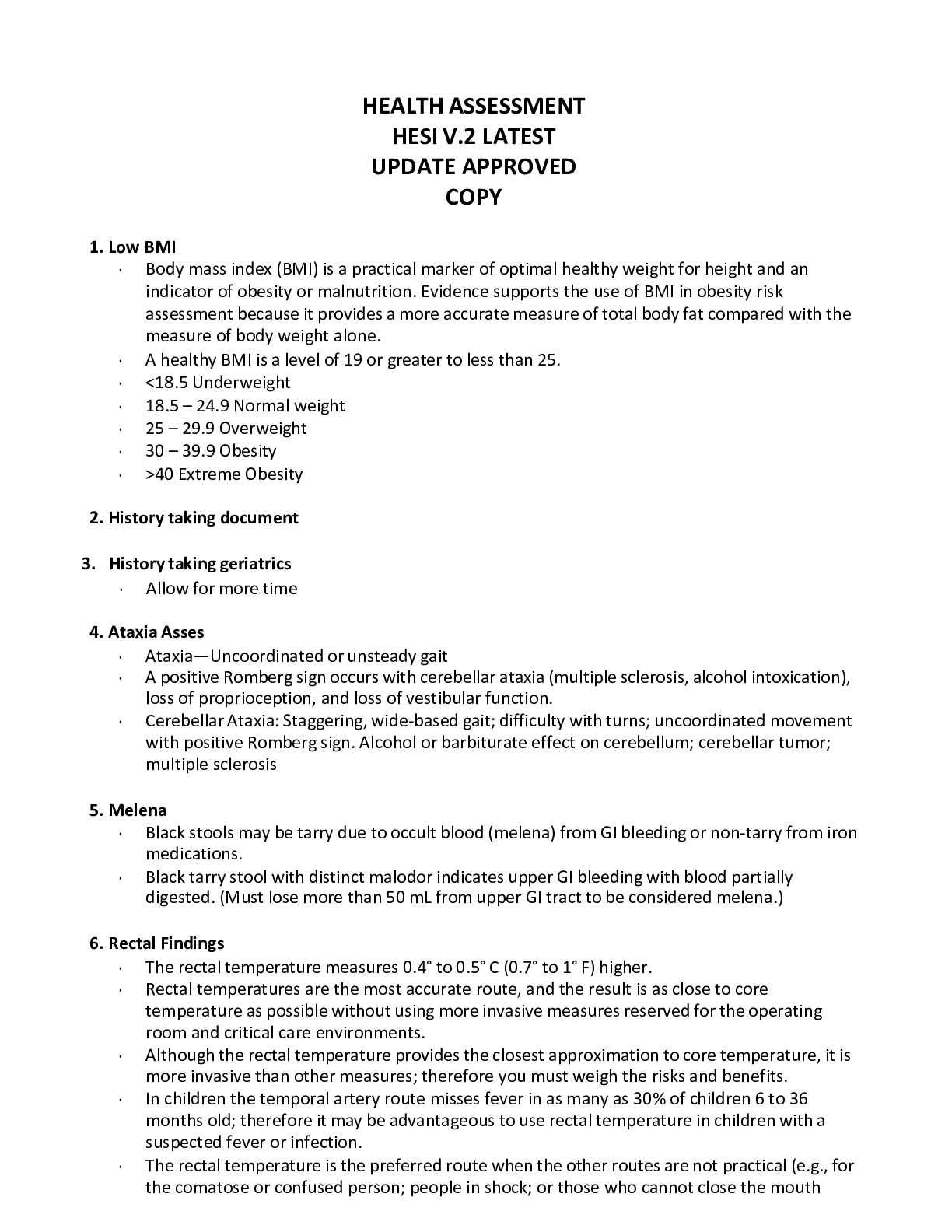
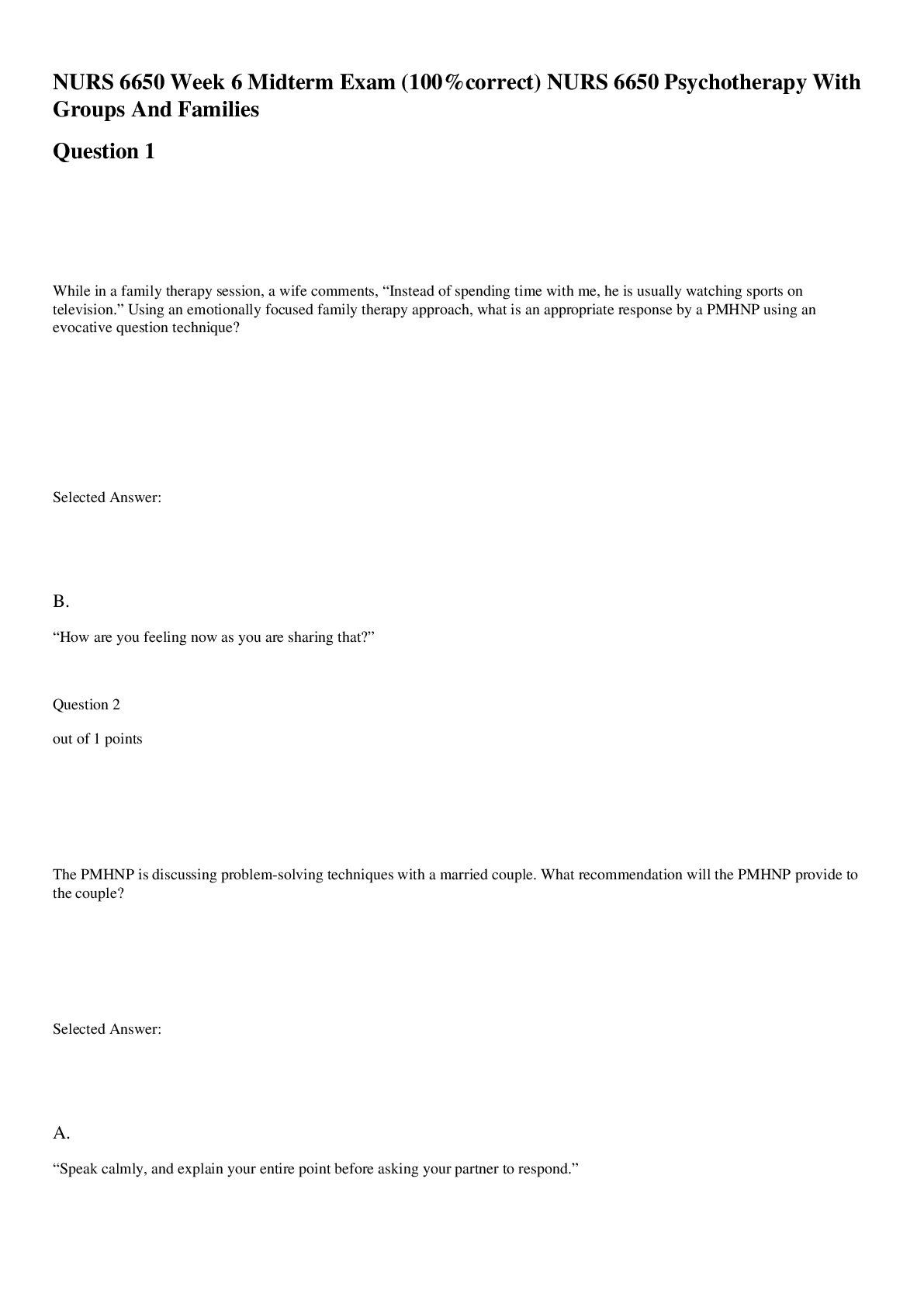
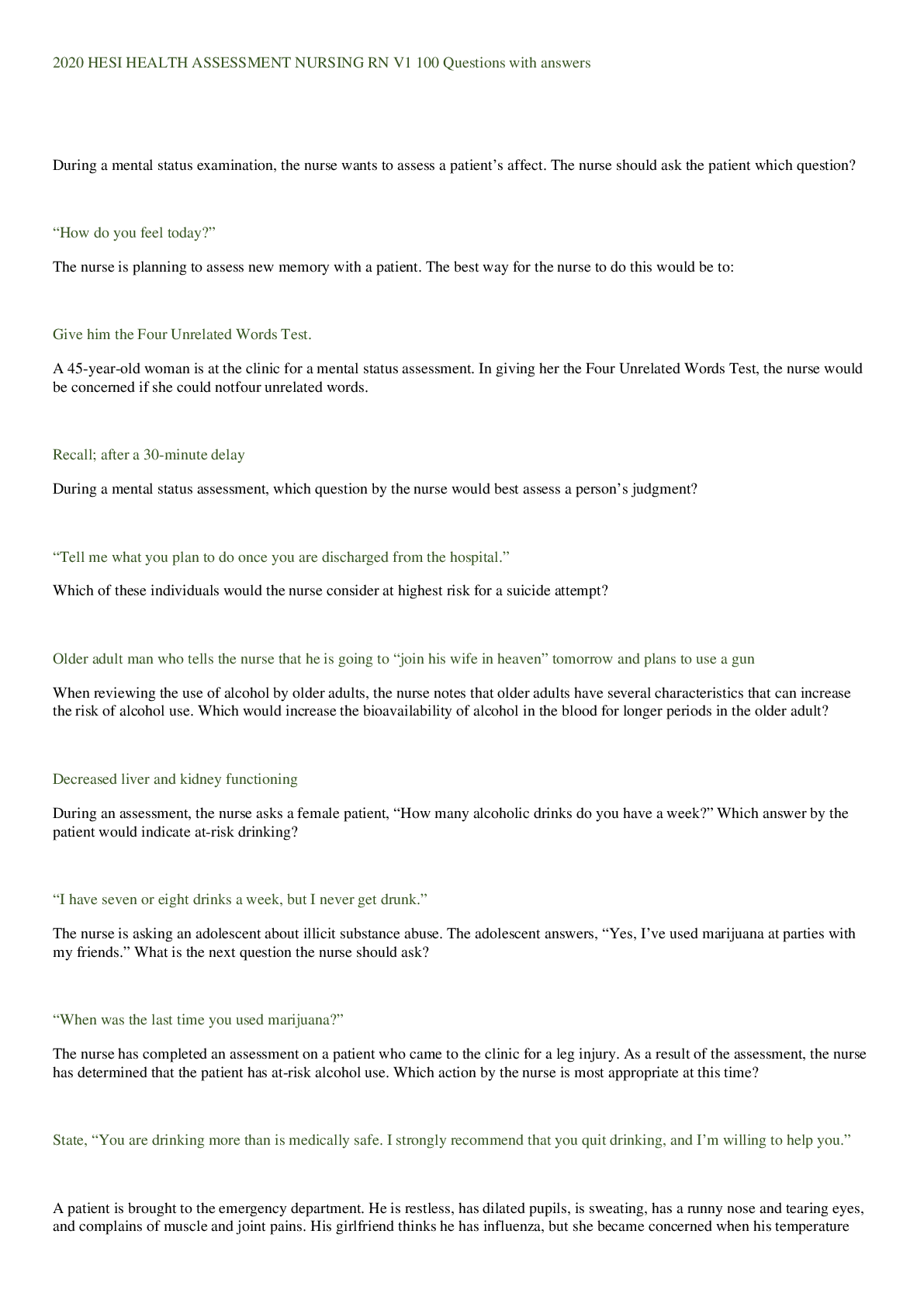
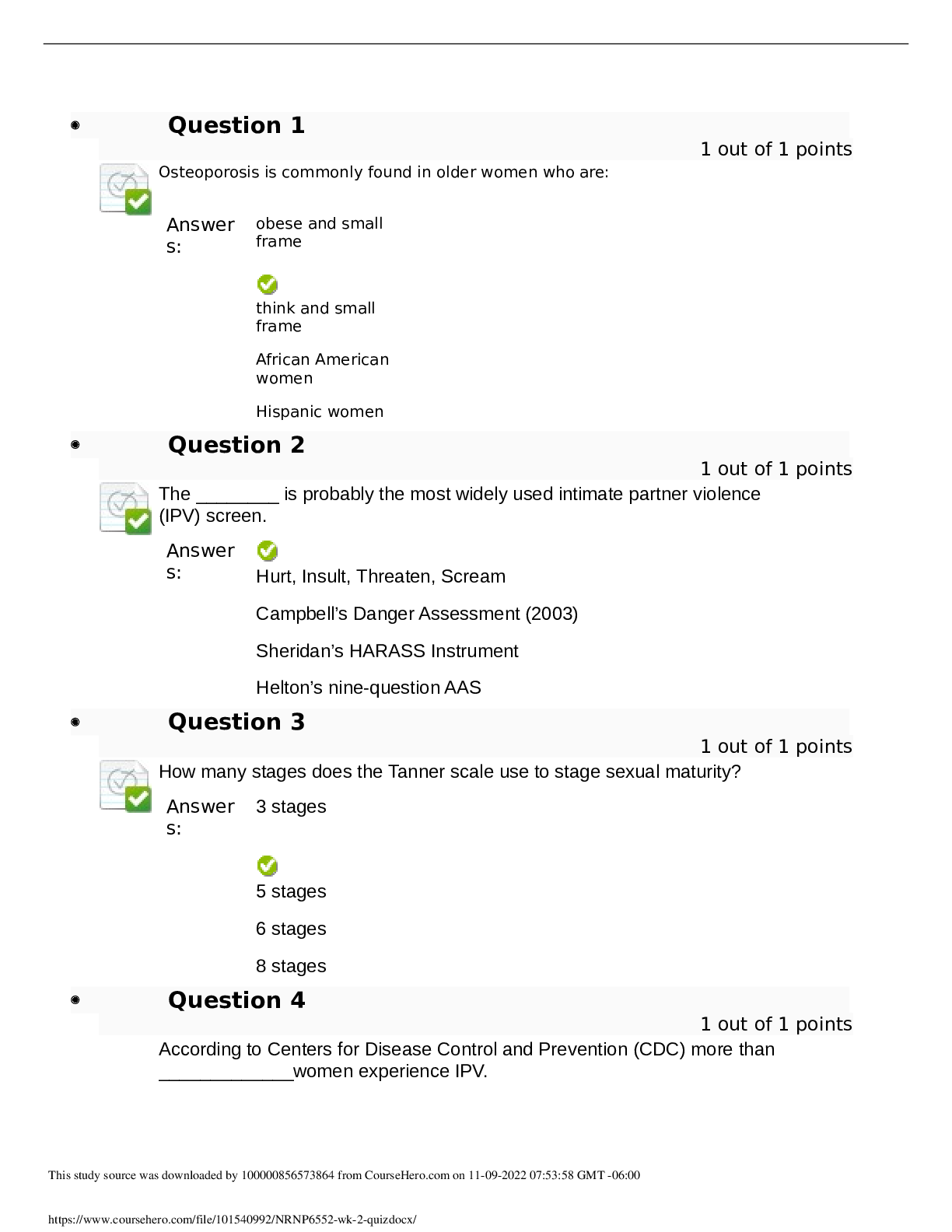


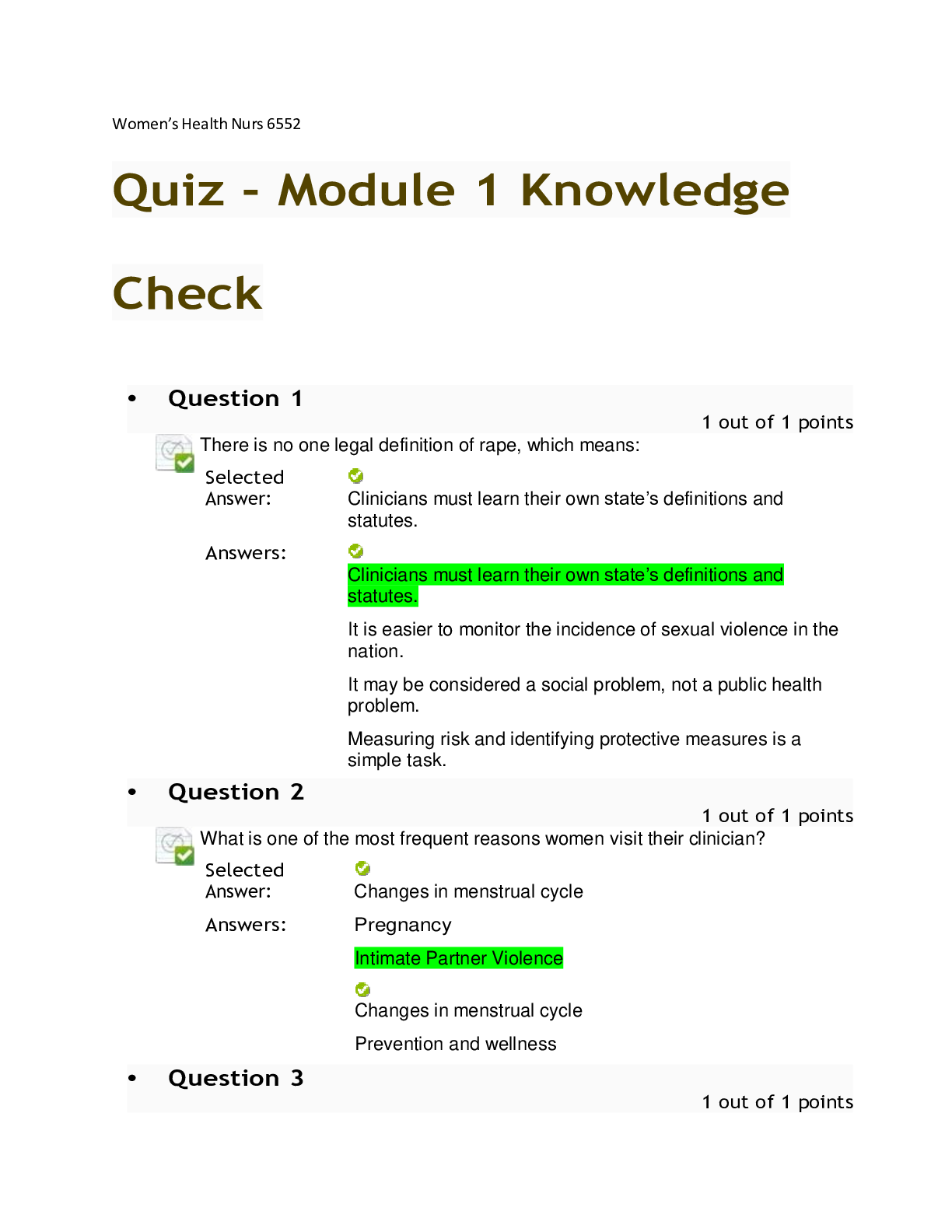
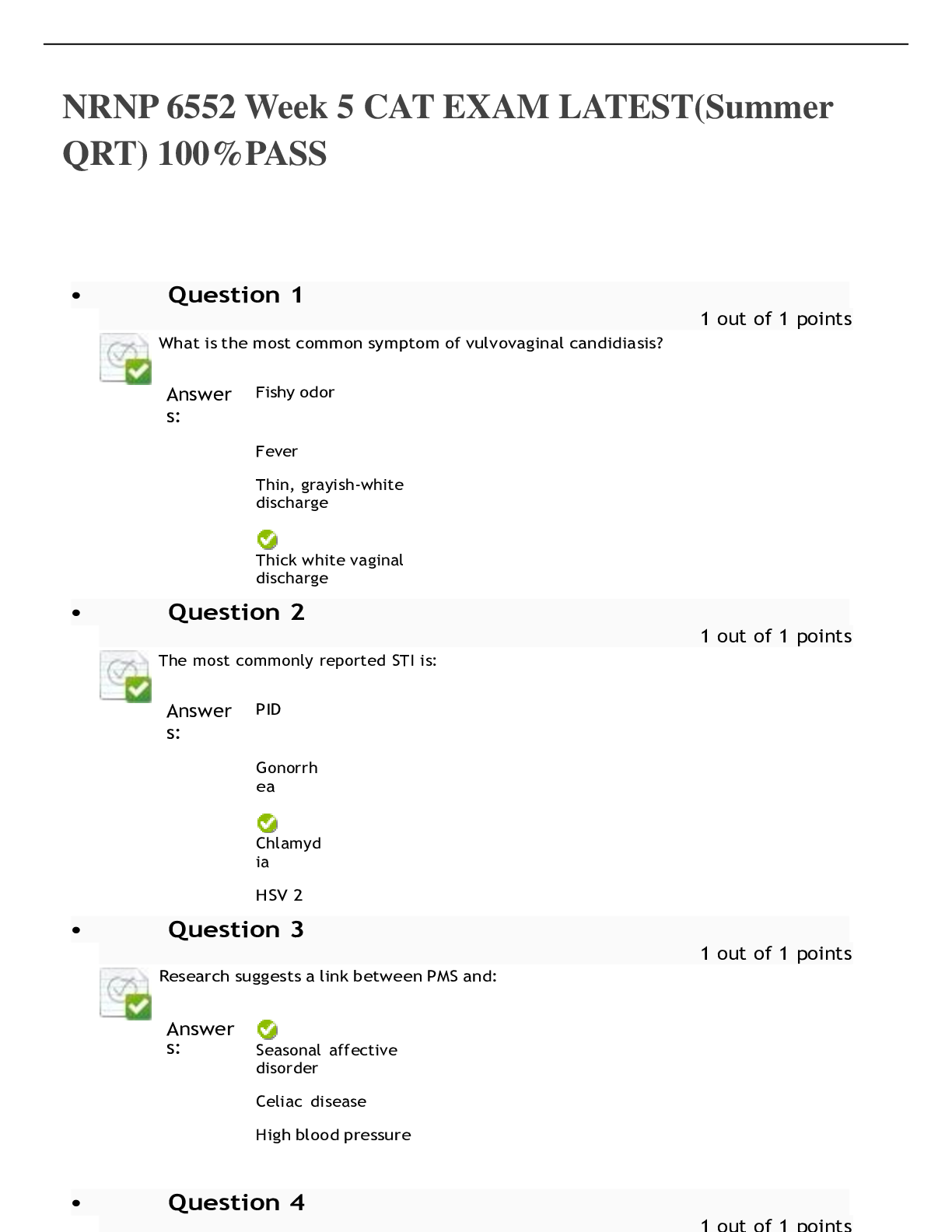
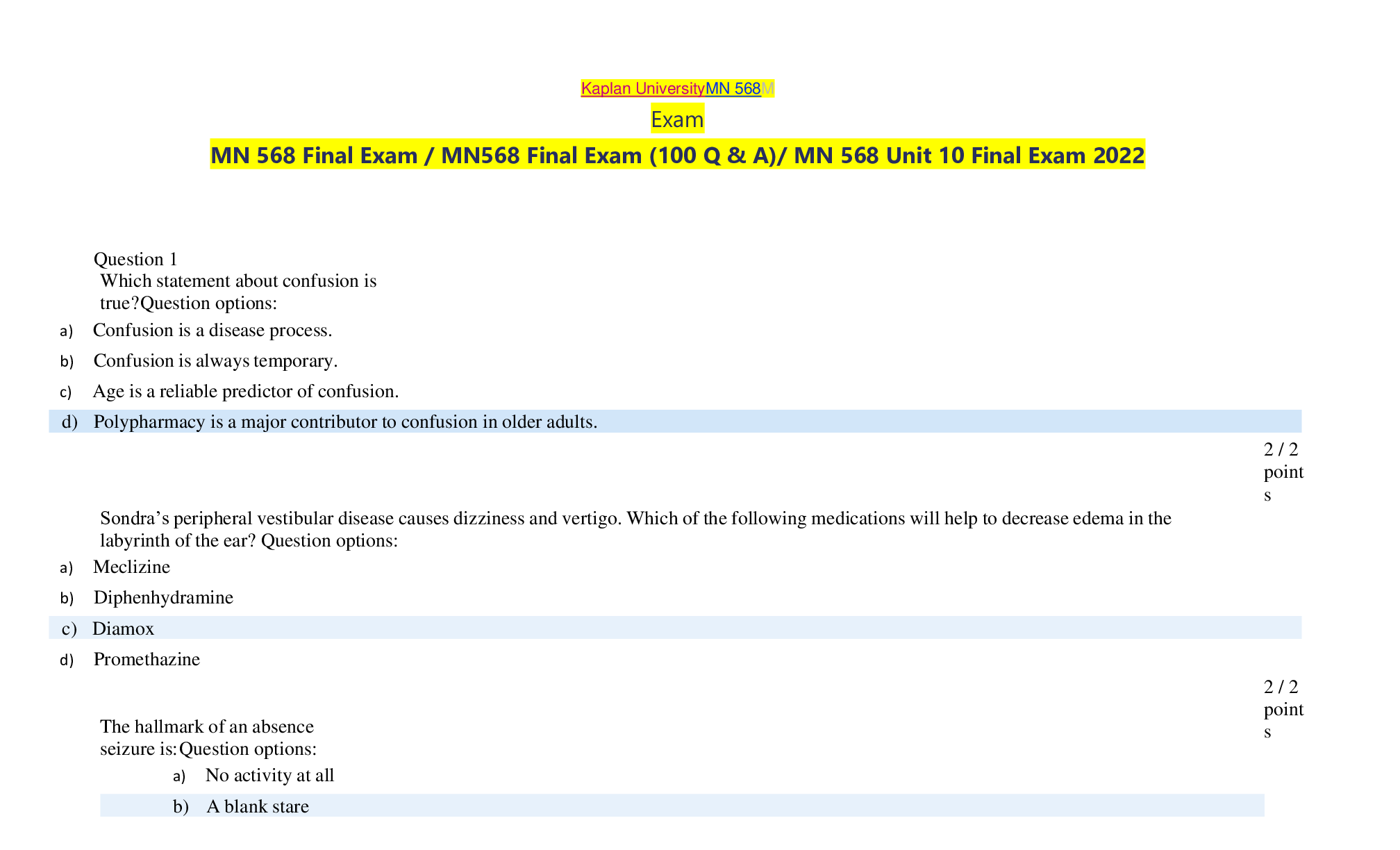
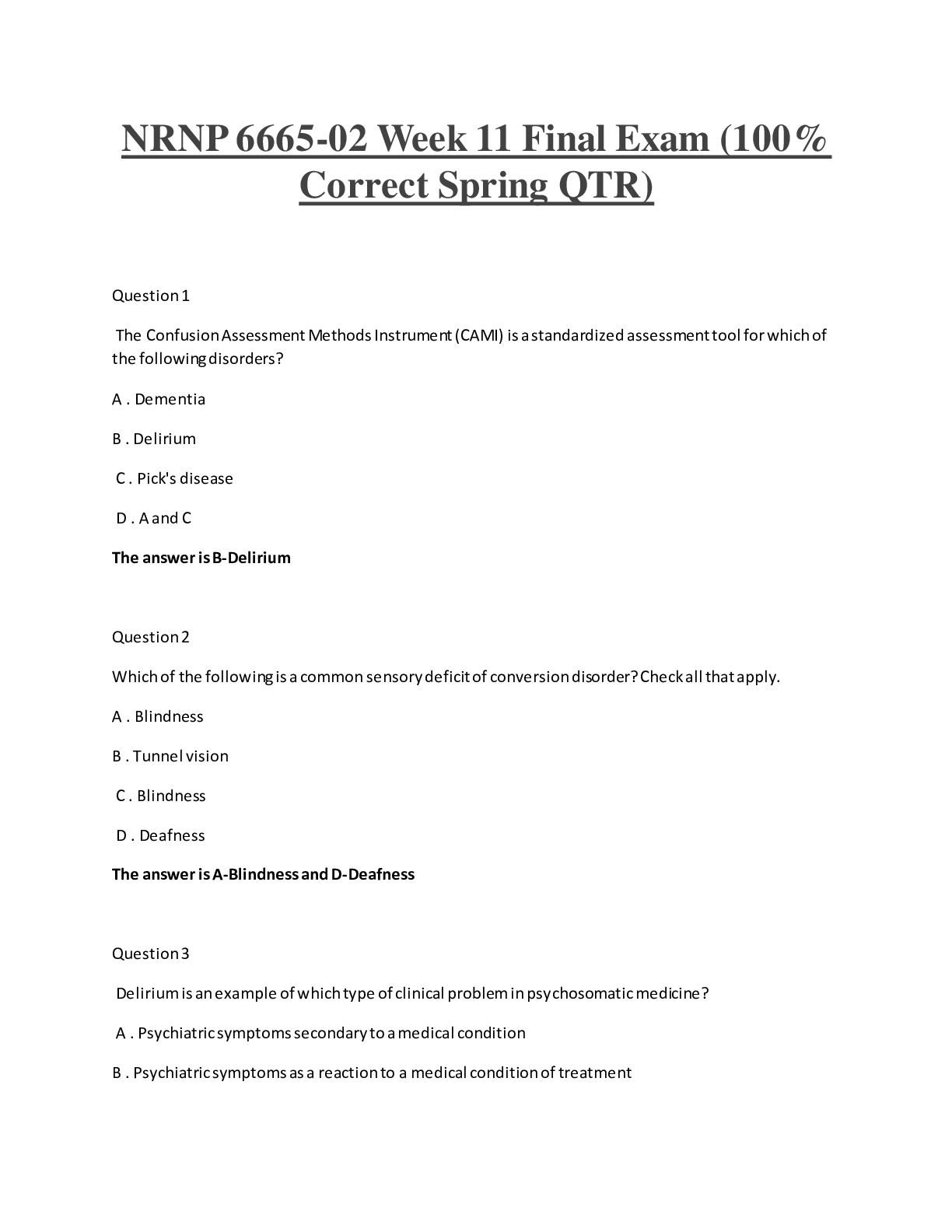
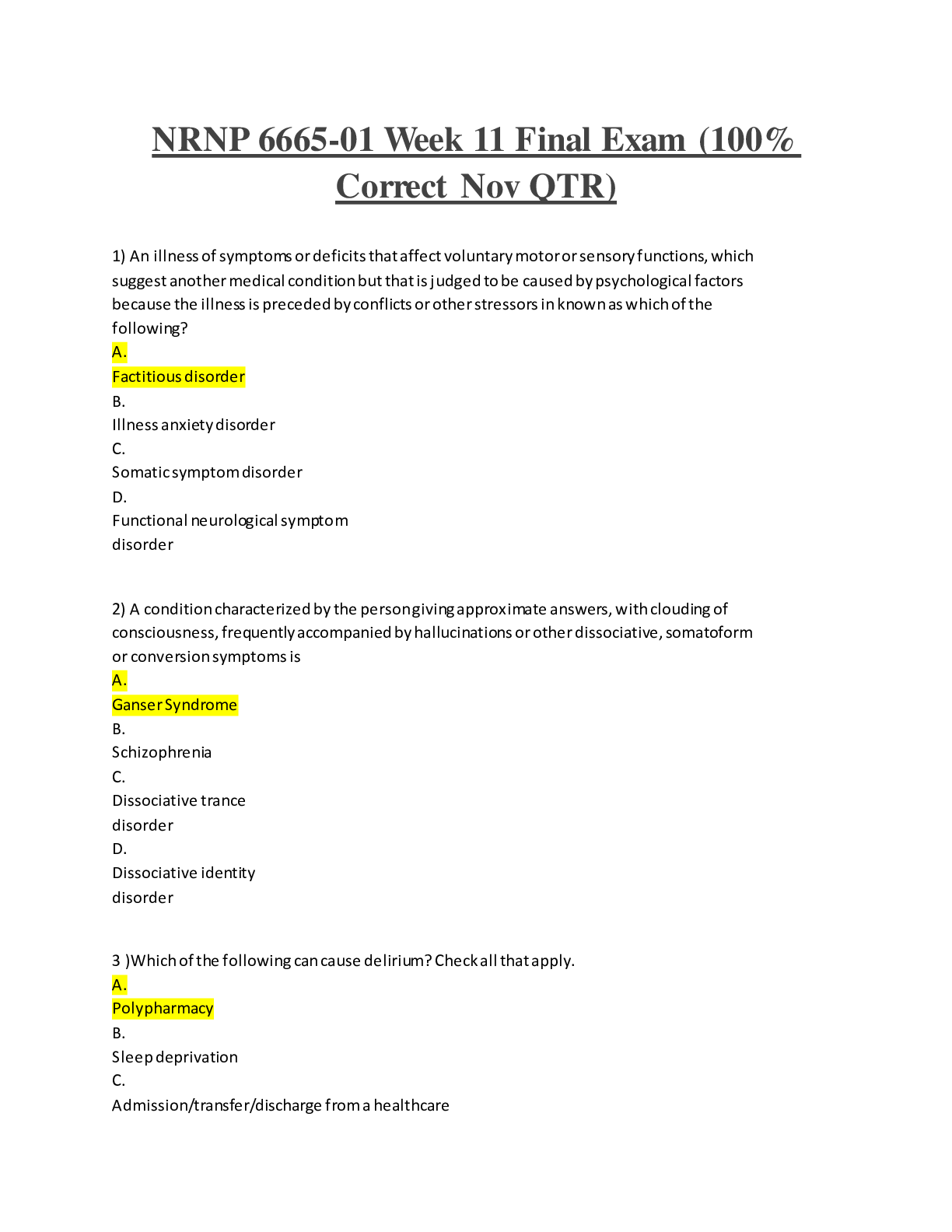



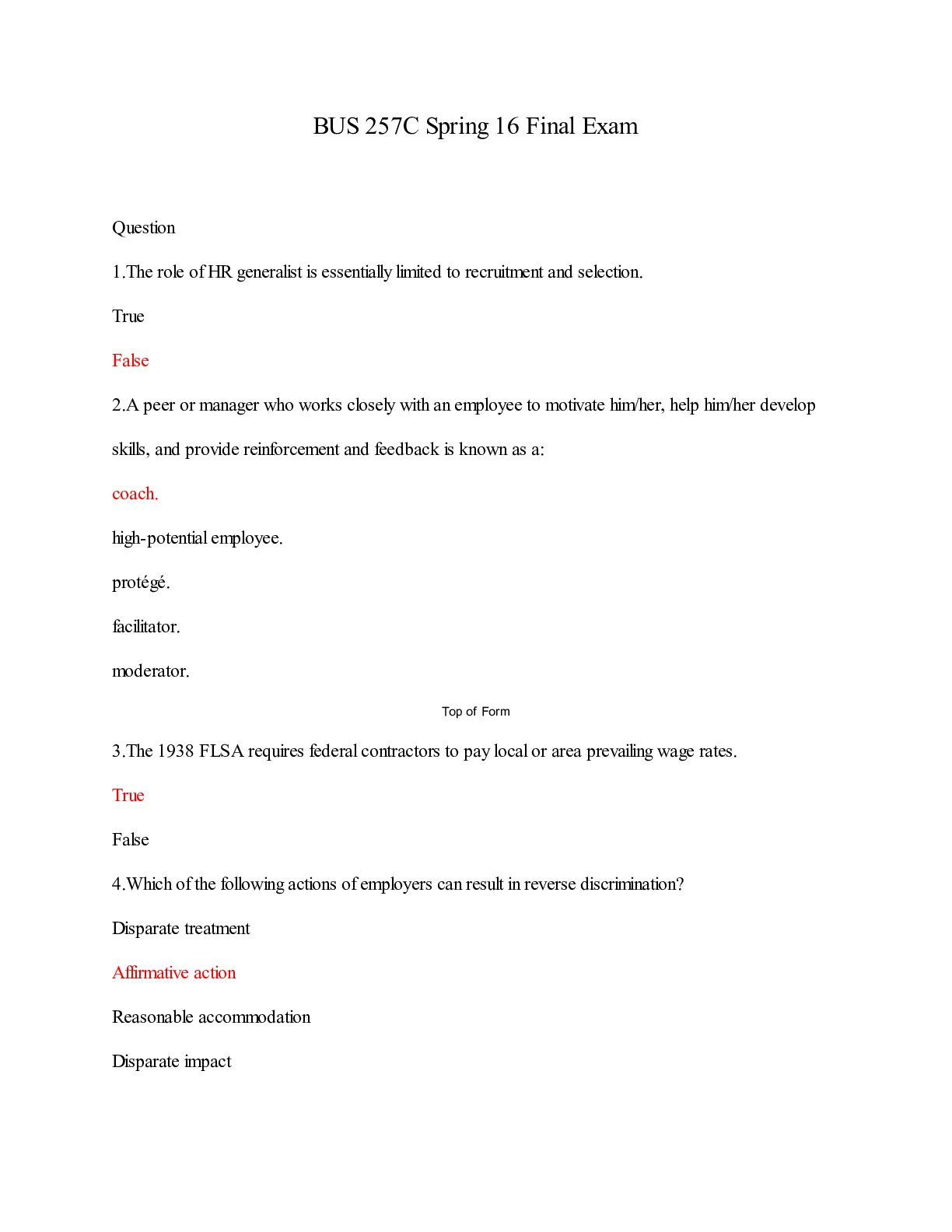


.png)
